Examples of step-level conditional dependencies evaluation
If you configured HCL Workload Automation for Z to track step-end events, then the step dependencies are checked at step-end time when the return code value is available.
This section contains an example showing how operation processing flow is affected when using step-level conditions.
Example of step-level dependency shows an example of conditional dependency logic
at job step level. In the figure, dotted lines represent conditional dependencies and straight lines
represent normal dependencies. Figure 1. Example of step-level dependency
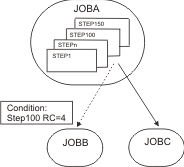

- JOBB can start if STEP100, belonging to JOBA, ends with RC=4.
- JOBC is a normal successor of JOBA and therefore starts if JOBA status is C (Completed).
The operation processing
proceeds based on possible STEP100 return
codes and
JOB_A statuses: - STEP100 ends with RC=4; JOBA status is not yet completed
- Step dependency status evaluation if Step100
ends with return code 4 and JOBA status is not yet completed shows the
operation processing flow:
Figure 2. Step dependency status evaluation if Step100 ends with return code 4 and JOBA status is not yet completed 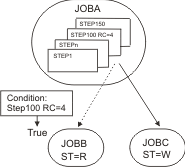
JOBB can start processing, if free from other dependencies, even if JOBA has not yet ended processing.
- STEP100 ends with RC=8; JOBA status is not yet completed
- Step dependency status evaluation if Step100
ends with return code 8 and JOBA status is not yet completed shows
the
operation processing flow:
Figure 3. Step dependency status evaluation if Step100 ends with return code 8 and JOBA status is not yet completed 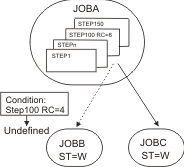
- The step-level condition is set to U (Undefined).
- JOBB status is set to W (Wait).
- STEP100 ends with RC=8; JOBA ends successfully
- Step dependency status evaluation if Step100
ends with return code 8 and JOBA ends successfully shows the
operation processing flow:
Figure 4. Step dependency status evaluation if Step100 ends with return code 8 and JOBA ends successfully 
- JOBC can start processing, if free from other dependencies.
- The step-level condition status is set to F (False).
- JOBB status is set to X (Suppressed by condition).
- STEP100 ends with RC=8; JOBA ends in error
- Step dependency status evaluation if Step100 ends with return
code 8 and JOBA ends in error shows the operation
processing flow:
Figure 5. Step dependency status evaluation if Step100 ends with return code 8 and JOBA ends in error 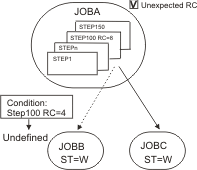
- JOBA ended in error, therefore its normal successor, JOBC is set to W (Wait).
- The step-level condition is not evaluated again and so its status remains U (Undefined) and JOBB status remains W (Wait).
- JOBA is marked with the Unexpected RC flag and the warning message EQQE142W is logged in the controller MLOG and in the system log.
Now the operator can examine the reason why JOBA failed and then either rerun the occurrence or fix the error and continue the processing.
- No step-end event is received for STEP100; JOBA ends successfully
- Step dependency status evaluation if no step-end event is received for Step100 and JobA ends successfully shows the operation processing flow:
Figure 6. Step dependency status evaluation if no step-end event is received for Step100 and JobA ends successfully 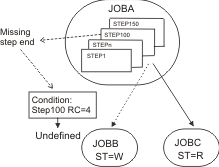
A possible path exists because JOBA has completed successfully and a normal successor, JOBC, exists.- JOBC can start processing, if free from other dependencies.
- The step-level condition is left U (Undefined) and the warning message EQQE127W is logged in the controller MLOG and in the system log.
- JOBB status remains W.
- No step-end event is received for STEP100; JOBA ends in error
- Step dependency status evaluation if no step-end event is received
for Step100 and JOBA ends in error shows the operation
processing flow:
Figure 7. Step dependency status evaluation if no step-end event is received for Step100 and JOBA ends in error 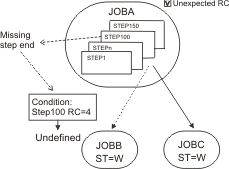 In this case a possible path in the plan does not exist:
In this case a possible path in the plan does not exist:- JOBC status remains W (Wait).
- The step-level condition is left as U (Undefined) and the warning message EQQE127W is logged in the controller MLOG and in the system log.
- JOBB status remains W.
- JOBA is marked with the Unexpected RC flag and the EQQE141W message is logged.